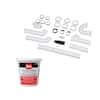Installing a garbage disposal is easy. Once you’ve installed one you’ve pretty much installed them all. With the right tools and a bit of patience, you’ll have your new garbage disposal up and running in no time. Here’s how to do it.
Tips for Success
- Use the right size unit: Ensure your garbage disposal matches your household needs (e.g., 1/2 HP for small homes, 1 HP for larger ones).
ToolRev earns commissions on purchases made through our links.
Here the disposal is plugged into a switched wall outlet. If your outlet is not connected to a wall switch you can use a disposal switch such as this Danco Air Switch.
Oatey 1-1/2 in. White Plastic Slip-Joint Garbage Disposal Install Kit with 14 oz. Plumber’s Putty









